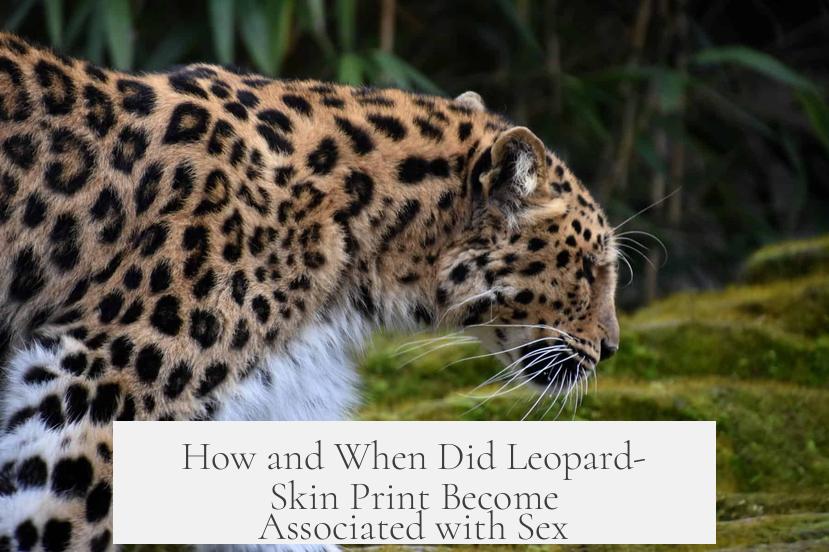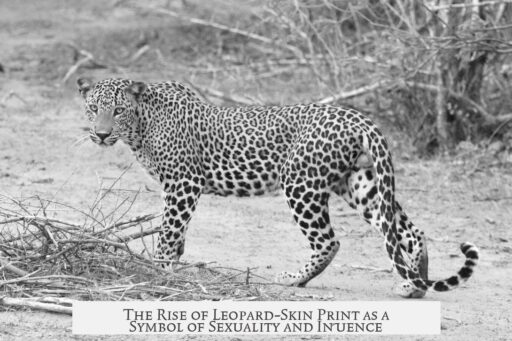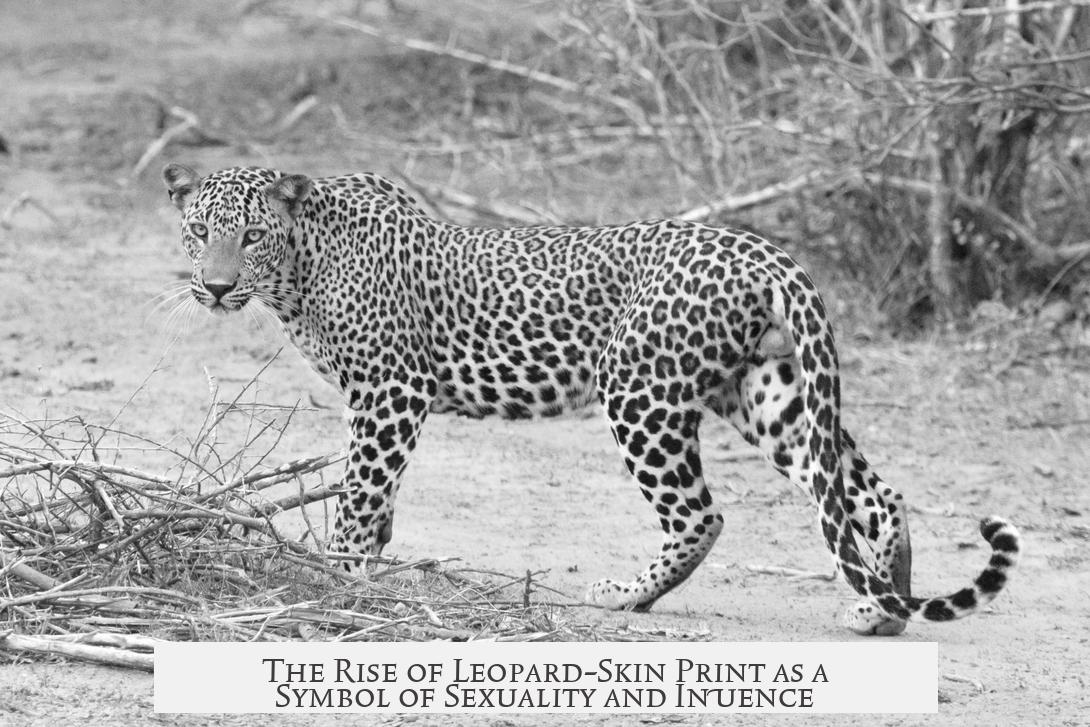Leopard-skin print becomes linked to sex largely through 20th-century fashion and popular culture, building on ancient associations with power and wildness. Historically, leopard skins symbolize strength and raw, untamed energy. This symbolism forms the backdrop for the pattern’s later sexualized meanings.
In the 1940s, fashion designer Christian Dior popularizes leopard print as a daring statement. Dior famously warns, “If you’re fair and sweet, don’t wear it!” This comment frames the print as a mark of bold, untamed femininity and sexual independence. Leopard print shifts from merely exotic to explicitly suggestive.
Popular culture cements this sexual symbolism in the 1960s. Anne Bancroft’s role as Mrs. Robinson in the film The Graduate makes a powerful impact. Bancroft wears leopard print clothing and lingerie while seducing a younger man. This portrayal associates leopard print with predatory female sexuality. The character’s confident allure links the pattern directly to seduction.
At the same time, social perceptions complicate leopard print’s image. Its sexual associations breed tension with issues of class and taste. Leopard print sometimes gains a reputation for lowbrow vulgarity rather than elegant sex appeal. This duality means the pattern can be seen as both seductive and trashy.
- Ancient symbolism connects leopard skin with wild power and ferocity.
- Christian Dior promotes leopard print in the 1940s as a symbol of bold, erotic femininity.
- Anne Bancroft’s Mrs. Robinson in The Graduate popularizes leopard print’s link to predatory sexuality.
- Leopard print’s sex appeal is often paired with perceptions of poor taste and low class.
Leopard print’s journey from wild animal pattern to sex symbol unfolds through layered cultural shifts in fashion and media. Its charged meaning blends power, danger, and feminine allure, making it a complex icon of sexuality.
How and When Did Leopard-Skin Print Become Associated with Sex?

The leopard-skin print became tied to sex primarily during the 20th century, as designers and popular culture framed it as a symbol of bold, untamed femininity and predatory female sexuality. Let’s dive into this fascinating transformation — from ancient symbols of power to modern interpretations of sex appeal.
Have you ever wondered why leopard print instantly conjures images of seduction or wildness? This isn’t a random association. It’s a story that unfolds over centuries, weaving together culture, fashion, and social attitudes.
From Power Symbol to Sexy Statement: The Historical Roots
The link between leopard skins and notions of power and raw, feral strength stretches back to ancient times. Wearing actual leopard pelts was once a sign of courage, prowess, and status. Kings and warriors donned them to project dominance and fearlessness.
This primal connection to power and the wild laid the groundwork for future interpretations. Leopard print was, quite literally, the pattern of the powerful — a wearable declaration of strength in a guise of beauty and danger.
Christian Dior and the 1940s Leopard Revolution

The 20th century is the era when leopard print’s connotations took a sharp turn towards sex appeal. Enter Christian Dior, the influential fashion designer of the 1940s. Dior was the first major figure to promote leopard print as more than just a status symbol — he positioned it as a “bold fashion statement.”
Dior reportedly said, “If you’re fair and sweet, don’t wear it!” This suggests that leopard print was now for women who refused to be subdued or domesticated.
Dior basically gave leopard print a sexy new edge — framing the pattern as a symbol of untamed femininity and daring independence. It wasn’t just clothing; it was a statement against conformity. Leopard print appealed to women who wanted to break norms, daring to be both powerful and alluring simultaneously.
Hollywood’s Impact: Mrs. Robinson and the Predator’s Wardrobe
If Dior set the fashion tone, Hollywood soon cemented leopard print’s place as a marker of sexuality with a predatory twist. The 1967 film The Graduate features Anne Bancroft as Mrs. Robinson, a character who epitomizes seductive, predatory female sexuality.
Bancroft’s Mrs. Robinson wore multiple leopard-print garments, including lingerie, as she seduced her daughter’s boyfriend. This visual association stamped leopard print as a symbol of sexual power and danger.
This wasn’t just a stylish choice; it was a deliberate signal. Leopard print became shorthand for women who dared to claim sexual dominance, who hunted rather than being hunted. The role deepened the public’s perception of the print as something “sexy” — yes — but also morally complicated and provocative.
The Double Edge: Sex Appeal Meets Social Judgment

But leopard print’s association with sex isn’t universally glamorous. Alongside its seductive image came tangled social perceptions. Leopard print also gathered a reputation for poor taste, especially linked with lower-class or “trashy” fashion.
Though seen as seductive, leopard print was often considered vulgar or tawdry. This created a tension between its sex appeal and its social class connotations.
Think of it as the pattern that flirted with elegance but sometimes got caught in the company of irony or criticism. This duality made leopard print a complex cultural signifier — alluring to some, but divisive to others.
What Does This Mean Today?
Leopard print’s journey from royal power symbol to daring fashion statement to a marker of seductive danger shows how cultural meanings evolve over time.
Today, when someone wears leopard print, they are often seen as confident, bold, and maybe even a little rebellious — qualities that once defined warrior kings and now define a brand of sexy independence. However, the residue of earlier associations with trashiness still lingers, making this pattern a stylish gamble.
Practical Lessons for Wearing Leopard Print
- Own your confidence: The print signals strength and audacity. Wearing it demands owning that attitude.
- Know your context: Leopard print can project different messages in a nightclub versus a business meeting. Adjust accordingly.
- Pair smartly: To bypass tackiness, combine leopard print with neutral or classic fashion pieces.
Leopard print’s wild, sexy reputation started with kings and keepers of power, was thrust into the spotlight by Dior’s rebellious designs, further sharpened by Hollywood’s sultry predators, and complicated by social judgments. This rich history makes it one of the most intriguing fashion patterns ever.
So next time you see leopard print, ask yourself: Are you ready to wear the power, the allure, the untamed spirit this pattern represents?
When did leopard-skin print first become linked to sexuality?
In the 1940s, Christian Dior promoted leopard print as a bold fashion choice for women who resisted being tame. This linked the print to strong, independent female sexuality.
How did popular culture reinforce leopard print’s sexual image?
Anne Bancroft’s role as Mrs. Robinson in “The Graduate” made the print a symbol of predatory female sexuality. Her character’s leopard-print lingerie became iconic for seduction.
Why is leopard print sometimes seen as tasteless despite its sex appeal?
Leopard print’s sexual image is mixed with class perceptions. It was often viewed as vulgar or low-class, which caused tension between its seductive and trashy reputation.
What historical meanings did leopard skins have before the 20th century?
Leopard skins symbolized power and wild strength for centuries. This raw, untamed association laid the groundwork for their later sexual symbolism.



